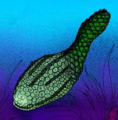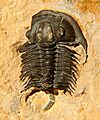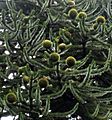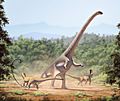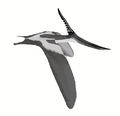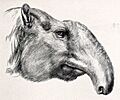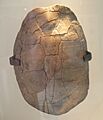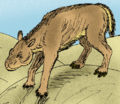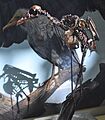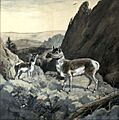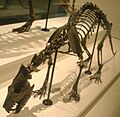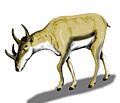List of the prehistoric life of Wyoming facts for kids
Wyoming is a state in the western United States, and it's famous for its amazing fossil discoveries! This article is a list of the different kinds of ancient plants and animals that once lived in Wyoming, long before humans existed. Scientists have found their fossilized remains, which are like natural imprints or hardened parts of living things, preserved in rocks across the state. These fossils help us understand what life was like millions of years ago in Wyoming.
Contents
Ancient Life in Wyoming: The Paleozoic Era
The Paleozoic Era was a very long time ago, from about 541 to 252 million years ago. During this era, life on Earth was mostly in the oceans, but plants and early animals started to move onto land. Wyoming's rocks from this time show us a world very different from today.
Sea Creatures of the Paleozoic
Many of the fossils found from the Paleozoic Era in Wyoming are from creatures that lived in the sea. Imagine a time when Wyoming was covered by warm, shallow oceans!
- Actinoceras: These were ancient squid-like creatures with straight, cone-shaped shells. They could grow quite large!
- Astraspis: This was a very early type of fish that didn't have jaws. It looked a bit like a flat, armored fish.
- Composita: These were small, clam-like animals called brachiopods. They had two shells and lived attached to the seafloor.
- Endoceras: Another type of ancient squid relative, these had long, straight shells that could be several feet long.
- Helicoprion: This was a unique shark relative known for its strange "tooth whorl" – a spiral of teeth that looked like a circular saw.
- Meteoraspis: A type of trilobite, which were ancient sea arthropods with segmented bodies. They are often called "sea bugs."
- Plaesiomys: Another kind of brachiopod, similar to Composita, that lived in the Ordovician period.
- Saukiella: A trilobite from the Cambrian and Ordovician periods, known for its distinctive head and tail shields.
- Tricrepicephalus: This was another type of trilobite, often found in Cambrian rocks.
Other Paleozoic Fossils
Besides the sea creatures, some early plants and other animals have been found.
- Burnetia: This was a type of synapsid, an animal group that includes the ancestors of mammals. It lived during the Permian period.
- Dentalium: These are often called "tusk shells" because they look like tiny, hollow tusks. They were a type of mollusk.
- Favosites: A type of coral that formed honeycomb-like colonies.
- Lingula: A very ancient type of brachiopod that has changed very little over millions of years.
- Psilophyton: One of the earliest known land plants, it had simple stems and no true leaves.
Giants of the Mesozoic Era in Wyoming
The Mesozoic Era, from about 252 to 66 million years ago, is often called the "Age of Dinosaurs." Wyoming has some of the most famous dinosaur fossil sites in the world!
Dinosaurs and Their Relatives
Wyoming was home to many different kinds of dinosaurs, from huge long-necked plant-eaters to fierce meat-eaters.
- Allosaurus: A large, meat-eating dinosaur that lived during the Late Jurassic period. It was one of the top predators of its time.
- Ankylosaurus: This dinosaur was like a living tank! It was a heavily armored dinosaur with a club-like tail for defense.
- Apatosaurus: A giant, long-necked plant-eating dinosaur, also known as a sauropod. It was one of the largest land animals ever.
- Barosaurus: Another massive long-necked dinosaur, similar to Apatosaurus, known for its very long neck and tail.
- Brachiosaurus: Famous for its long front legs and giraffe-like neck, making it one of the tallest dinosaurs.
- Brontosaurus: A well-known long-necked dinosaur, closely related to Apatosaurus. It was a massive plant-eater.
- Camarasaurus: A medium-sized sauropod with a distinctive boxy skull. It was a common plant-eater in the Late Jurassic.
- Camptosaurus: A plant-eating dinosaur that could walk on two or four legs. It was an early relative of the duck-billed dinosaurs.
- Ceratosaurus: A meat-eating dinosaur with a horn on its snout and bony ridges above its eyes.
- Coelurus: A small, agile meat-eating dinosaur, one of the early tyrannosaur relatives.
- Deinonychus: A fierce, bird-like meat-eating dinosaur with a large, sickle-shaped claw on each foot. It was a "raptor."
- Diplodocus: One of the longest dinosaurs, known for its extremely long neck and whip-like tail.
- Dryosaurus: A small, fast-running plant-eating dinosaur.
- Edmontosaurus: A large duck-billed dinosaur, known for its wide, flat snout.
- Gargoyleosaurus: An early armored dinosaur with bony plates and spikes covering its body.
- Hesperosaurus: A type of Stegosaurus with broad, flat plates along its back.
- Leptoceratops: A small, early horned dinosaur that lived in the Late Cretaceous.
- Microvenator: A small, bird-like meat-eating dinosaur.
- Nanosaurus: A small, plant-eating dinosaur.
- Nodosaurus: Another armored dinosaur, similar to Ankylosaurus, but without the tail club.
- Ornitholestes: A small, agile meat-eating dinosaur.
- Ornithomimus: A "bird-mimic" dinosaur that looked like a modern ostrich. It was fast and likely ate plants and small animals.
- Othnielosaurus: A small, plant-eating dinosaur.
- Pachycephalosaurus: Famous for its thick, dome-shaped skull, which it might have used for head-butting.
- Poposaurus: A crocodile relative that walked on two legs, living during the Late Triassic.
- Sauropelta: A medium-sized armored dinosaur with large shoulder spikes.
- Sauroposeidon: One of the tallest dinosaurs ever, with an incredibly long neck.
- Stegosaurus: A very famous dinosaur with large, upright plates along its back and a spiked tail.
- Supersaurus: One of the longest dinosaurs, even longer than Diplodocus.
- Tanycolagreus: A medium-sized meat-eating dinosaur.
- Tenontosaurus: A large, plant-eating dinosaur known for its long tail.
- Thescelosaurus: A small, plant-eating dinosaur that lived at the very end of the dinosaur age.
- Torosaurus: A large horned dinosaur, similar to Triceratops, with two large holes in its frill.
- Torvosaurus: A very large and powerful meat-eating dinosaur, one of the biggest predators of the Late Jurassic.
- Triceratops: One of the most recognizable dinosaurs, with three horns on its face and a large bony frill.
- Troodon: A small, bird-like meat-eating dinosaur with large eyes, suggesting it hunted at night.
- Tyrannosaurus: The most famous meat-eating dinosaur, known for its massive size and powerful bite.
Marine Reptiles and Other Sea Life
Wyoming was also home to incredible marine reptiles during the Mesozoic Era, as parts of the state were covered by a vast inland sea.
- Baculites: A type of ammonite, which were shelled squid-like creatures. Baculites had straight, uncoiled shells.
- Baptanodon: A marine reptile called an ichthyosaur, which looked like a dolphin or fish.
- Dolichorhynchops: A type of plesiosaur, a long-necked marine reptile with four flippers.
- Inoceramus: A giant clam-like bivalve mollusk that could grow to enormous sizes.
- Megalneusaurus: A very large plesiosaur, one of the biggest marine predators of its time.
- Ophthalmosaurus: Another ichthyosaur, known for its very large eyes, suggesting it hunted in deep or dark waters.
- Platecarpus: A type of mosasaur, a large, powerful marine lizard that was a top predator in the Late Cretaceous seas.
- Plesiopleurodon: A type of plesiosaur with a short neck and large head.
- Styxosaurus: A very long-necked plesiosaur.
- Xiphactinus: A giant, predatory bony fish that could grow up to 17 feet long.
Ancient Flying Reptiles
- Pteranodon: A large pterosaur, a flying reptile, known for its long, toothless beak and a crest on its head.
- Pterodactylus: A smaller pterosaur, one of the first flying reptiles to be discovered.
Other Mesozoic Animals and Plants
- Acipenser: A type of sturgeon, a large bony fish that still lives today.
- Adocus: An ancient turtle.
- Albanerpeton: A small, lizard-like amphibian.
- Amia: A type of bowfin fish, which still exists today.
- Araucaria: A type of conifer tree, similar to modern "monkey puzzle" trees.
- Cimolomys: A small, early mammal related to multituberculates.
- Coniophis: One of the earliest known snakes.
- Didelphodon: A marsupial relative, similar to an opossum.
- Diplomystus: A type of bony fish, often found in fossil lakes.
- Ginkgo: A type of tree that has survived since the time of the dinosaurs.
- Gobiconodon: An early mammal with strong teeth.
- Koskinonodon: A large, crocodile-like amphibian.
- Squalicorax: A type of shark, often called the "crow shark."
- Zamites: A type of cycad-like plant, similar to a palm or fern.
Life After Dinosaurs: The Cenozoic Era in Wyoming
The Cenozoic Era, from 66 million years ago to today, is known as the "Age of Mammals." After the dinosaurs disappeared, mammals and birds became the dominant large animals. Wyoming has many fossils from this time, showing how life changed and evolved.
Mammals of the Cenozoic
Wyoming was home to many different kinds of mammals, from tiny early primates to giant rhinos and mammoths.
- Aepycamelus: A long-necked camel, sometimes called the "giraffe-camel."
- Agriochoerus: A hoofed mammal that looked a bit like a sheep or goat, but was related to camels.
- Archaeotherium: A large, pig-like mammal often called a "hell pig" or "terminator pig."
- Arctodus: The short-faced bear, one of the largest bears that ever lived.
- Barylambda: A large, heavy plant-eating mammal from the Paleocene-Eocene.
- Bison: Large horned mammals, including the ancestors of modern bison.
- Bootherium: An extinct musk ox relative.
- Brachycrus: A type of oreodont, a group of hoofed mammals unique to North America.
- Camelops: An extinct camel that lived in North America.
- Canis dirus: The dire wolf, a large and powerful wolf that lived during the Ice Age.
- Carpolestes simpsoni: A very early primate relative, known for its grasping hands and feet.
- Coryphodon: A large, heavy plant-eating mammal that lived in the early Cenozoic.
- Daphoenodon: A "bear-dog," a type of ancient carnivore that looked like a mix between a bear and a dog.
- Daphoenus: Another type of bear-dog.
- Diceratherium: An early rhinoceros with two horns side-by-side on its nose.
- Dinictis: An early saber-toothed cat.
- Dinohyus: A giant pig-like mammal, even larger than Archaeotherium.
- Eobasileus: A huge, rhino-like mammal with multiple horns on its head.
- Eohippus: The "dawn horse," a small, early horse ancestor with multiple toes.
- Epihippus: A slightly more advanced horse ancestor.
- Equus conversidens: An extinct species of horse that lived in North America.
- Hyaenodon: A large, powerful meat-eating mammal, related to hyenas.
- Hypohippus: A three-toed horse that lived in forests.
- Icaronycteris: One of the earliest known bats, found in Wyoming's Green River Formation.
- Knightia: A very common fossil fish found in Wyoming.
- Leptauchenia: A small oreodont with a short face.
- Mammuthus columbi: The Columbian mammoth, a giant extinct elephant that lived during the Ice Age.
- Megacerops: A giant rhino-like mammal with a large, blunt horn on its snout.
- Merychippus: A three-toed horse that was a grazer, eating grass.
- Mesohippus: An early horse ancestor, slightly larger than Eohippus.
- Mesonyx: A wolf-like meat-eating mammal with hooves instead of claws.
- Metacheiromys: An early pangolin relative.
- Metamynodon: A large, semi-aquatic rhino relative.
- Miohippus: Another early horse ancestor.
- Mioplosus: A type of perch-like fish.
- Moropus: A strange hoofed mammal with claws instead of hooves, related to horses and rhinos.
- Notharctus: An early primate, similar to a lemur.
- Onychonycteris: One of the earliest known bats, with claws on all its fingers.
- Orohippus: An early horse ancestor, slightly larger than Eohippus.
- Oxydactylus: A long-necked camel.
- Palaeolagus: An early rabbit.
- Pantolambda: A large, early plant-eating mammal.
- Patriofelis: A large, cat-like meat-eating mammal.
- Phareodus: A large, predatory bony fish.
- Plesiadapis: An early primate with rodent-like teeth.
- Presbyornis: An early waterfowl, similar to a duck or goose.
- Protoceras: A deer-like mammal with bony horns on its head and snout.
- Ptilodus: A small, early mammal with unique teeth, related to multituberculates.
- Ramoceros: An extinct pronghorn relative with branched horns.
- Saniwa: A large monitor lizard.
- Sinopa: A small, weasel-like meat-eating mammal.
- Smilodectes: An early primate.
- Stenomylus: A small, slender camel.
- Subhyracodon: An early rhinoceros.
- Syndyoceras: A deer-like mammal with unusual, branched horns.
- Teleoceras: A short-legged, barrel-bodied rhinoceros.
- Titanoides: A large, heavy plant-eating mammal.
- Titanomyrma: A giant extinct ant.
- Trogosus: A large, rodent-like mammal.
- Uintatherium: A massive, rhino-like mammal with bony knobs and horns on its head.
Birds of the Cenozoic
Many types of ancient birds have been found in Wyoming, including ancestors of modern birds.
- Accipiter striatus: The sharp-shinned hawk, a small, fast hawk.
- Aegolius acadicus: The northern saw-whet owl.
- Aegolius funereus: The Boreal owl.
- Aquila chrysaetos: The golden eagle.
- Asio otus: The long-eared owl.
- Buteo jamaicensis: The red-tailed hawk.
- Caracara plancus: The crested caracara, a type of falcon.
- Centrocercus urophasianus: The greater sage-grouse.
- Chordeiles minor: The common nighthawk.
- Colaptes auratus: The northern flicker, a type of woodpecker.
- Corvus brachyrhynchos: The American crow.
- Corvus corax: The common raven.
- Dendragapus obscurus: The dusky grouse.
- Diatryma: A giant, flightless predatory bird.
- Ectopistes migratorius: The passenger pigeon, now extinct.
- Falco mexicanus: The prairie falcon.
- Fluvioviridavis: An early bird.
- Grus canadensis: The sandhill crane.
- Lagopus leucurus: The white-tailed ptarmigan.
- Limnofregata: An early frigatebird, a type of seabird.
- Lithornis: An early bird, similar to a tinamou.
- Mergus merganser: The common merganser, a type of duck.
- Neocathartes grallator: An extinct vulture-like bird.
- Nucifraga columbiana: The Clark's nutcracker.
- Numenius americanus: The long-billed curlew.
- Numenius borealis: The Eskimo curlew, now extinct.
- Nyctea scandiaca: The snowy owl.
- Phalaenoptilus nuttallii: The common poorwill.
- Pica pica: The black-billed magpie.
- Pipilo chlorurus: The green-tailed towhee.
- Porzana carolina: The sora, a type of rail.
- Pseudocrypturus: An early bird.
- Sturnella neglecta: The western meadowlark.
- Surnia ulula: The hawk owl.
- Tachycineta bicolor: The tree swallow.
- Turdus migratorius: The American robin.
- Tympanuchus phasianellus: The sharp-tailed grouse.
- Zonotrichia albicollis: The white-throated sparrow.
Reptiles and Amphibians of the Cenozoic
Wyoming's Cenozoic fossils also include many reptiles and amphibians, showing the diversity of life in warmer climates.
- Allognathosuchus: An extinct crocodile relative.
- Apalone: A type of softshell turtle.
- Boavus: An ancient boa snake.
- Borealosuchus: An extinct crocodile.
- Boverisuchus: A crocodile relative.
- Ceratosuchus: A crocodile relative with horn-like bumps on its head.
- Chisternon: An ancient turtle.
- Coniophis: An early snake.
- Crocodylus affinis: An extinct crocodile species.
- Diplocynodon: An extinct alligator relative.
- Echmatemys: An ancient turtle.
- Helodermoides: An extinct lizard, related to Gila monsters.
- Lisserpeton: An ancient salamander.
- Peltosaurus: An extinct lizard.
- Piceoerpeton: An ancient salamander.
- Pristichampsus: A land-dwelling crocodile.
- Saniwa: A large monitor lizard.
- Siren: A type of aquatic salamander.
Plants of the Cenozoic
Wyoming's Cenozoic plant fossils show a shift from tropical forests to more temperate environments.
- Acer: Maple trees.
- Alnus: Alder trees.
- Aralia: A type of flowering plant.
- Araucaria: A type of conifer tree.
- Asplenium: A type of fern.
- Betula: Birch trees.
- Carya: Hickory trees.
- Castanea: Chestnut trees.
- Celastrus: A type of vine.
- Celtis: Hackberry trees.
- Cercidiphyllum: Katsura trees.
- Cinnamomum: Cinnamon trees.
- Cissus: Grape vines.
- Cladrastis: Yellowwood trees.
- Cornus: Dogwood trees.
- Corylus: Hazelnut trees.
- Crataegus: Hawthorn trees.
- Diospyros: Persimmon trees.
- Dryopteris: A type of fern.
- Equisetum: Horsetails.
- Eucommia: A type of tree.
- Ficus: Fig trees.
- Fraxinus: Ash trees.
- Ginkgo: Ginkgo trees.
- Glyptostrobus: A type of cypress tree.
- Juglans: Walnut trees.
- Kalmia: Mountain laurel.
- Laurus: Laurel trees.
- Liquidambar: Sweetgum trees.
- Lygodium: Climbing ferns.
- Magnolia: Magnolia trees.
- Metasequoia: Dawn redwood trees.
- Myrica: Bayberry shrubs.
- Nelumbo: Lotus plants.
- Onoclea: Sensitive ferns.
- Osmunda: Royal ferns.
- Paliurus: Christ's thorn.
- Persea: Avocado trees.
- Phoenicites: A type of palm.
- Phragmites: Reed grasses.
- Pinus: Pine trees.
- Pistacia: Pistachio trees.
- Pistia: Water lettuce.
- Platanus: Sycamore trees.
- Populus: Poplar trees.
- Potamogeton: Pondweeds.
- Prunus: Cherry and plum trees.
- Ptelea: Hoptrees.
- Pterocarya: Wingnut trees.
- Quercus: Oak trees.
- Rhamnus: Buckthorn shrubs.
- Robinia: Locust trees.
- Salix: Willow trees.
- Salvinia: Water ferns.
- Sassafras: Sassafras trees.
- Schoepfia: Whitewood trees.
- Sequoia: Redwood trees.
- Smilax: Greenbrier vines.
- Sparganium: Bur-reeds.
- Sterculia: A type of flowering tree.
- Stillingia: A type of plant.
- Styrax: Storax trees.
- Symplocos: Sweetleaf trees.
- Taxodium: Bald cypress trees.
- Thelypteris: A type of fern.
- Thuja: Arborvitae trees.
- Tilia: Linden trees.
- Trapa: Water chestnuts.
- Typha: Cattails.
- Ulmus: Elm trees.
- Viburnum: Viburnum shrubs.
- Vitis: Grape vines.
- Williamsonia: An extinct cycad-like plant.
- Woodwardia: Chain ferns.
- Zamia: A type of cycad.
- Zelkova: Zelkova trees.
- Zizyphus: Jujube trees.
Images for kids
-
Life restoration of the Permian Chimaera relative Helicoprion
-
Life restoration of the Late Jurassic theropod dinosaur Allosaurus
-
Life restoration of the Late Cretaceous armored dinosaur Ankylosaurus
-
Foliage and cones of a living Araucaria tree
-
Restoration of the Late Jurassic sauropod dinosaur Barosaurus rearing to defend itself against a pair of the theropod Allosaurus
-
Life restoration of a herd of the Late Jurassic sauropod dinosaur Brontosaurus
-
Restoration of the Late Jurassic ceratosaur Ceratosaurus
-
Life restoration of the Late Jurassic primmitive tyrannosaur Coelurus
-
Illustration of fossilized vertebrae of the Late Cretaceous-Eocene snake Coniophis. Othniel Charles Marsh (1892).
-
Life restoration of the Early Cretaceous dromaeosaur ("raptor") Deinonychus
-
Life restoration of the Late Jurassic long-necked dinosaur Diplodocus
-
Life restoration of the Late Cretaceous duck-billed dinosaur Edmontosaurus annectens
-
Mounted fossilized skeleton of the Late Jurassic armored dinosaur Gargoyleosaurus
-
Life restoration of the Late Cretaceous primitive horned dinosaur Leptoceratops
-
Life restoration of the Early Cretaceous oviraptorosaur Microvenator
-
Life restoration of the Late Jurassic ichthyosaur Ophthalmosaurus
-
Life restoration of the Late Cretaceous pterosaur Pteranodon
-
Diagram illustrating the Early Cretaceous long-necked dinosaur Sauroposeidon with an anachronistic human to scale
-
Restoration of the Late Jurassic stegosaur Stegosaurus
-
Restoration in multiple views of the Late Jurassic sauropod dinosaur Supersaurus with an anachronistic human to scale
-
Life restoration of the Late Cretaceous herbivorous dinosaur Thescelosaurus
-
Mounted fossilized skeleton of the Late Cretaceous horned dinosaur Triceratops
-
Fossilized skeleton of the Late Cretaceous tyrannosaur Tyrannosaurus
-
Living adult (center) and chick (lower right) Accipiter striatus, or sharp-shinned hawks
-
A living Spatula clypeata, or northern shoveler
-
Restoration of an Arctodus, or short-faced bear, with a human to scale
-
A living Asio otus, or long-eared owl
-
A living Buteo jamaicensis, or red-tailed hawk
-
Modern mounted skeleton of Canis lupus, the grey wolf, to scale with a fossilized skeleton of the Pleistocene wolf Canis dirus, or dire wolf
-
Life restoration of a pair of the Eocene uintathere mammal Eobasileus. Charles R. Knight (1890s).
-
Life restoration of a herd of Mammuthus columbi, or Columbian mammoths. The extent of the fur depicted is hypothetical. Charles R. Knight (1909).
-
A living Panthera leo, or lion
-
Life restoration of the Eocene creodont mammal Patriofelis. Charles R. Knight (1896).
-
Life restoration of the Paleocene-Eocene waterfowl Presbyornis
-
Life restoration of a female (left) and male of the Oligocene-Miocene even-toed ungulate Protoceras. Charles R. Knight (1896).
-
Leaves and fruit of a living Viburnum.


